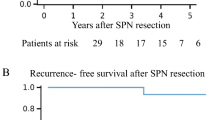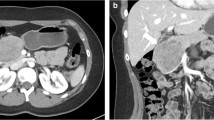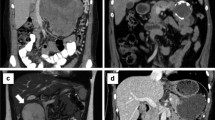Abstract
Purpose
Pancreatic neoplasms are uncommon in children. This study sought to analyze the clinical and pathological features of surgically resected pancreatic tumors in children and discuss management strategies.
Methods
We conducted a retrospective review of patients ≤21 years with pancreatic neoplasms who underwent surgery at a single institution between 1995 and 2015.
Results
Nineteen patients were identified with a median age at operation of 16.6 years (IQR 13.5–18.9). The most common histology was solid pseudopapillary neoplasm (SPN) (n = 13), followed by pancreatic neuroendocrine tumor (n = 3), serous cystadenoma (n = 2) and pancreatoblastoma (n = 1). Operative procedures included formal pancreatectomy (n = 17), enucleation (n = 1) and central pancreatectomy (n = 1). SPNs were noninvasive in all but one case with perineural, vascular and lymph node involvement. Seventeen patients (89.5 %) are currently alive and disease free at a median follow-up of 5.7 (IQR 3.7–10.9) years. Two patients died: one with metastatic insulinoma and another with SPN who developed peritoneal carcinomatosis secondary to a concurrent rectal adenocarcinoma.
Conclusions
Pediatric pancreatic tumors are a heterogeneous group of neoplastic lesions for which surgery can be curative. SPN is the most common histology, is characterized by low malignant potential and in selected cases can be safely and effectively treated with a tissue-sparing resection and minimally invasive approach.




Similar content being viewed by others
References
Perez EA, Gutierrez JC, Koniaris LG et al (2009) Malignant pancreatic tumors: incidence and outcome in 58 pediatric patients. J Pediatr Surg 44:197–203
Grosfeld JL, Vane DW, Rescorla FJ et al (1990) Pancreatic tumors in childhood: analysis of 13 cases. J Pediatr Surg 25:1057–1062
Jaksic T, Yaman M, Thorner P et al (1992) A 20-year review of pediatric pancreatic tumors. J Pediatr Surg 27:1315–1317
Shorter NA, Glick RD, Klimstra DS et al (2002) Malignant pancreatic tumors in childhood and adolescence: the Memorial Sloan-Kettering experience, 1967 to present. J Pediatr Surg 37:887–892
Yu DC, Kozakewich HP, Perez-Atayde AR et al (2009) Childhood pancreatic tumors: a single institution experience. J Pediatr Surg 44:2267–2272
van den Akker M, Angelini P, Taylor G et al (2012) Malignant pancreatic tumors in children: a single-institution series. J Pediatr Surg 47:681–687
Rojas Y, Warneke CL, Dhamne CA et al (2012) Primary malignant pancreatic neoplasms in children and adolescents: a 20 year experience. J Pediatr Surg 47:2199–2204
Nasher O, Hall NJ, Sebire NJ et al (2015) Pancreatic tumours in children: diagnosis, treatment and outcome. Pediatr Surg Int 31:831–835
Dall’igna P, Cecchetto G, Bisogno G et al (2010) Pancreatic tumors in children and adolescents: the Italian TREP project experience. Pediatr Blood Cancer 54:675–680
Park JK, Cho EJ, Ryu JK et al (2013) Natural history and malignant risk factors of solid pseudopapillary tumors of the pancreas. Postgrad Med 125:92–99
Speer AL, Barthel ER, Patel MM et al (2012) Solid pseudopapillary tumor of the pancreas: a single-institution 20-year series of pediatric patients. J Pediatr Surg 47:1217–1222
Lee SE, Jang JY, Hwang DW et al (2008) Clinical features and outcome of solid pseudopapillary neoplasm: differences between adults and children. Arch Surg 143:1218–1221
Choi SH, Kim SM, Oh JT et al (2006) Solid pseudopapillary tumor of the pancreas: a multicenter study of 23 pediatric cases. J Pediatr Surg 41:1992–1995
Fais PO, Carricaburu E, Sarnacki S et al (2009) Is laparoscopic management suitable for solid pseudo-papillary tumors of the pancreas? Pediatr Surg Int 25:617–621
Ellerkamp V, Warmann SW, Vorwerk P et al (2012) Exocrine pancreatic tumors in childhood in Germany. Pediatr Blood Cancer 58:366–371
Law JK, Ahmed A, Singh VK et al (2014) A systematic review of solid-pseudopapillary neoplasms: are these rare lesions? Pancreas 43:331–337
Kang CM, Kim KS, Choi JS et al (2006) Solid pseudopapillary tumor of the pancreas suggesting malignant potential. Pancreas 32:276–280
Bhatnagar R, Olson MT, Fishman EK et al (2014) Solid-pseudopapillary neoplasm of the pancreas: cytomorphologic findings and literature review. Acta Cytol 58:347–355
Martin RC, Klimstra DS, Brennan MF et al (2002) Solid-pseudopapillary tumor of the pancreas: a surgical enigma? Ann Surg Oncol 9:35–40
Kim MJ, Choi DW, Choi SH et al (2014) Surgical treatment of solid pseudopapillary neoplasms of the pancreas and risk factors for malignancy. Br J Surg 101:1266–1271
Cavallini A, Butturini G, Daskalaki D et al (2011) Laparoscopic pancreatectomy for solid pseudo-papillary tumors of the pancreas is a suitable technique; our experience with long-term follow-up and review of the literature. Ann Surg Oncol 18:352–357
Graziosi L, Marino E, Rivellini R et al (2015) Retrospective analysis of short term outcomes after spleen-preserving distal pancreatectomy for solid pseudopapillary tumours. Int J Surg 21(Suppl 1):S26–S29
Song KB, Kim SC, Park JB et al (2011) Single-center experience of laparoscopic left pancreatic resection in 359 consecutive patients: changing the surgical paradigm of left pancreatic resection. Surg Endosc 25:3364–3372
Petrosyan M, Franklin AL, Jackson HT et al (2014) Solid pancreatic pseudopapillary tumor managed laparoscopically in adolescents: a case series and review of the literature. J Laparoendosc Adv Surg Tech A 24:440–444
Morikawa T, Onogawa T, Maeda S et al (2013) Solid pseudopapillary neoplasms of the pancreas: an 18-year experience at a single Japanese Institution. Surg Today 43:26–32
Choi KS, Chung JC, Kim HC (2014) Feasibility and outcomes of laparoscopic enucleation for pancreatic neoplasms. Ann Surg Treat Res 87:285–289
Hwang J, Kim DY, Kim SC et al (2014) Solid-pseudopapillary neoplasm of the pancreas in children: can we predict malignancy? J Pediatr Surg 49:1730–1733
Laje P, Bhatti TR, Adzick NS (2013) Solid pseudopapillary neoplasm of the pancreas in children: a 15-year experience and the identification of a unique immunohistochemical marker. J Pediatr Surg 48:2054–2060
Tipton SG, Smyrk TC, Sarr MG et al (2006) Malignant potential of solid pseudopapillary neoplasm of the pancreas. Br J Surg 93:733–737
Brient C, Regenet N, Sulpice L et al (2012) Risk factors for postoperative pancreatic fistulization subsequent to enucleation. J Gastrointest Surg 16:1883–1887
Manfredi R, Ventriglia A, Mantovani W et al (2015) Mucinous cystic neoplasms and serous cystadenomas arising in the body-tail of the pancreas: MR imaging characterization. Eur Radiol 25:940–949
Reid MD, Choi H, Balci S et al (2014) Serous cystic neoplasms of the pancreas: clinicopathologic and molecular characteristics. Semin Diagn Pathol 31:475–483
Dhebri AR, Connor S, Campbell F et al (2004) Diagnosis, treatment and outcome of pancreatoblastoma. Pancreatology 4:441–51 (Discussion 452–453)
Glick RD, Pashankar FD, Pappo A et al (2012) Management of pancreatoblastoma in children and young adults. J Pediatr Hematol Oncol 34(Suppl 2):S47–S50
Saif MW, Karapanagiotou L, Syrigos K (2007) Genetic alterations in pancreatic cancer. World J Gastroenterol 13:4423–4430
Lee YJ, Hah JO (2007) Long-term survival of pancreatoblastoma in children. J Pediatr Hematol Oncol 29:845–847
Bien E, Godzinski J, Dall’igna P et al (2011) Pancreatoblastoma: a report from the European cooperative study group for paediatric rare tumours (EXPeRT). Eur J Cancer 47:2347–2352
Defachelles AS, Martin De Lassalle E, Boutard P et al (2001) Pancreatoblastoma in childhood: clinical course and therapeutic management of seven patients. Med Pediatr Oncol 37:47–52
Yonekura T, Kosumi T, Hokim M et al (2006) Aggressive surgical and chemotherapeutic treatment of advanced pancreatoblastoma associated with tumor thrombus in portal vein. J Pediatr Surg 41:596–598
Eden OB, Shaw MP (1992) Chemotherapy for pancreaticoblastoma. Med Pediatr Oncol 20:357–359
Vossen S, Goretzki PE, Goebel U et al (1998) Therapeutic management of rare malignant pancreatic tumors in children. World J Surg 22:879–882
Baudin E, Caron P, Lombard-Bohas C et al (2014) Malignant insulinoma: recommendations for workup and treatment. Presse Med 43:645–659
Janem W, Sultan I, Ajlouni F et al (2010) Malignant insulinoma in a child. Pediatr Blood Cancer 55:1423–1426
Hirshberg B, Cochran C, Skarulis MC et al (2005) Malignant insulinoma: spectrum of unusual clinical features. Cancer 104:264–272
Lobe TE, Vera SR, Bowman LC et al (1992) Hepaticopancreaticogastroduodenectomy with transplantation for metastatic islet cell carcinoma in childhood. J Pediatr Surg 27:227–229
Author information
Authors and Affiliations
Corresponding author
Ethics declarations
Funding
This study was supported by the NIH Specialized Programs of Research Excellence P50-CA062924.
Conflict of interest
The authors declare that they have no conflicts of interest.
Rights and permissions
About this article
Cite this article
Sacco Casamassima, M.G., Gause, C.D., Goldstein, S.D. et al. Pancreatic surgery for tumors in children and adolescents. Pediatr Surg Int 32, 779–788 (2016). https://doi.org/10.1007/s00383-016-3925-y
Accepted:
Published:
Issue Date:
DOI: https://doi.org/10.1007/s00383-016-3925-y




